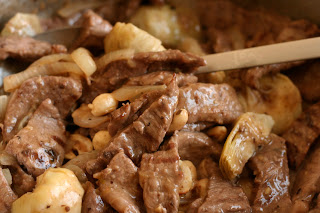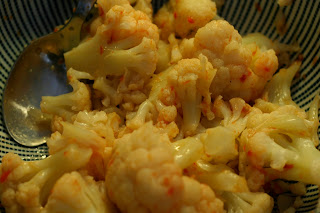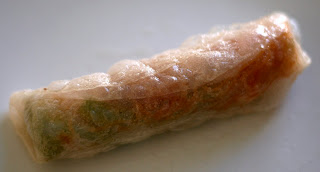I'm really lucky to have a brilliant butcher in my market in Cadiz. His name is Antonio Grimaldi, and he sells locally reared retinto beef which is a match for anything I can buy in Scotland. The other day I bought some thinly cut steaks, and this is what I came up with. I've never seen artichokes used in this way, but I think the result is a real success - one of those dishes where all the ingredients complement each other.
 Ingredients
Ingredients12 oz of beef steak, cut into thin strips
for the marinade2 teaspoons of light soy sauce
2 teaspoons of cider vinegar (or balsamic vinegar)
1 teaspoon of sesame oil
2 teaspoons of cornflour
1 tin of artichoke hearts, drained and cut into halves
2 tablespoons of cashew nuts
1/2 an onion, thinly sliced
2 teaspoons of minced ginger
2 teaspoons of minced garlic
2 teaspoons of rinsed, finely chopped black beans
vegetable oil
6 fl oz chicken stock
2 teaspoons of cornflour, dissolved in two teaspoons of water
Method- Place the steak in a large bowl. Combine the light soy sauce, cider vinegar, sesame oil and 2 teaspoons of cornflour, pour over the steak, mix and leave for 15 minutes or so.
- Cook the beef strips on a hot griddle pan, then set aside on a plate. Fry the cashew nuts for 30 seconds or so on the hot griddle pan, and add to the beef. (As I explain in my beef and oyster sauce recipe, this is a great way of ensuring that you dry-cook the meat, rather than 'sweating' it in the wok. The alternative is a very large wok, or batch cooking.)
- Heat some oil in a wok or large frying pan, fry the onion for a couple of minutes, add the garlic, ginger and black beans and fry for another 30 seconds or so, then add the chicken stock, bring to a simmer, add the dissolved cornflour and stir and heat until the sauce has thickened a little. Add the artichokes, stir gently to mix, and heat for another 30 seconds or so, add the beef, the cashew nuts and any juices from the plate, stir gently and heat for a few more seconds.
- Serve with plenty of boiled rice, and a fresh green salad.
 Black bean sauce
Black bean sauceA lot of Chinese bottled sauces are good - oyster, hoisin etc. - although they obviously vary from brand to brand. However, I think that the black bean sauce sold in jars is almost always pretty unpleasant. They tend to be way too salty, with nasty chemical overtones and a gloopy texture. I much prefer to use whole salted black beans, which you then rinse and chop, and add to your dish much as you would ginger or garlic.












